
- Index
- Age
- Format
- Maker
- Artist Signed (3)
- China (19)
- Chinese (7)
- Evelyn Ackerman (3)
- France (313)
- French (178)
- French Hand Carved (4)
- Hand Carved (8)
- Hand Made (21)
- Hand Made In France (8)
- Handemade (3)
- Handmade (98)
- India (4)
- Jungwirth (4)
- Made In France (25)
- Mogul Interior (3)
- Mogulinterior (4)
- Tribal (9)
- Unknown (113)
- Wood Carver (3)
- ... (4012)
- Material
- Beech (23)
- Carved Wood (9)
- Chestnut (8)
- Hand Carved Wood (150)
- Mango Wood (13)
- Oak (107)
- Oak Wood (26)
- Oak, Wood (11)
- Solid Oak (16)
- Solid Oak Wood (17)
- Solid Walnut (16)
- Solid Walnut Wood (34)
- Solid Wood (13)
- Teak Wood (36)
- Walnut (109)
- Wood (1147)
- Wood Solid Walnut (14)
- Wood, Oak (7)
- Wood, Paint (8)
- Wooden (64)
- ... (3014)
- Size
- 10” X 10” (2)
- 12 Inch Dia. (2)
- 12\ (2)
- 14 Inch X 35 Inch (4)
- 14\ (2)
- 21.65\ (2)
- 24 X 11 X 3 / 4 (3)
- 24\ (3)
- 24x12 (3)
- 40 X 12 X 1 (2)
- 76 X 21 X 5 Cm (2)
- Giant (over 60in.) (14)
- King (6)
- Large (57)
- Large (up To 60in.) (19)
- Medium (95)
- Medium (up To 36in.) (38)
- Queen (4)
- Small (6)
- Small (up To 12in.) (7)
- ... (4569)
- Type
- Carved Panel (16)
- Carved Wood Panel (17)
- Carving (189)
- Carvings (17)
- Door (25)
- Doors (19)
- Figurine (26)
- Light Sculpture (31)
- Panel (151)
- Panels (16)
- Plaque (17)
- Plaques / Signs (22)
- Room Divider (18)
- Sculpture (147)
- Statue (42)
- Wall Art (28)
- Wall Hanging (17)
- Wall Panel (49)
- Wall Sculpture (17)
- Wood Carving (111)
- ... (3867)
Antique Carved Wood Panel Sculpture of Acintya Supreme God Hindu Deity Museum
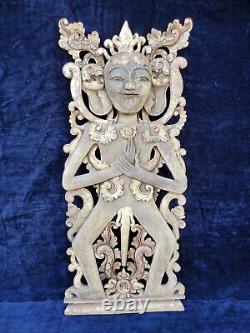
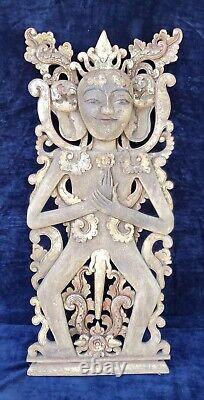
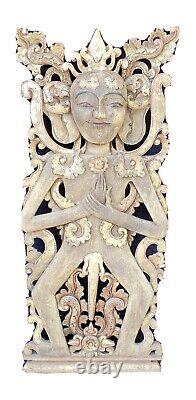
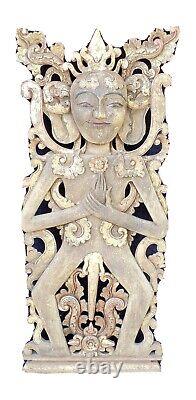
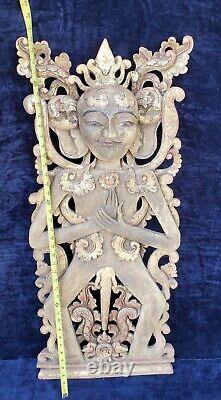
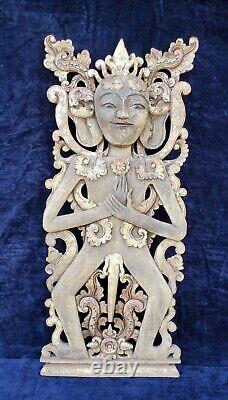
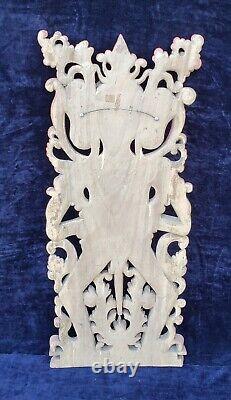
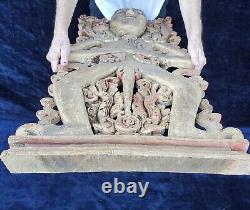
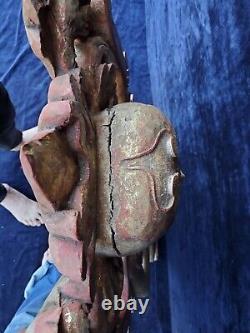
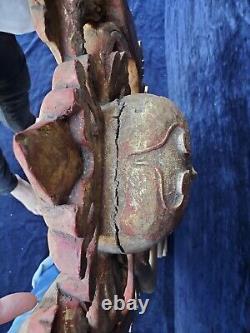
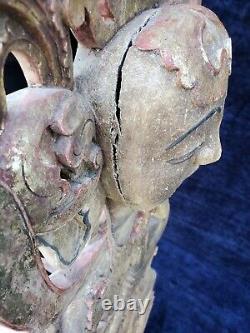
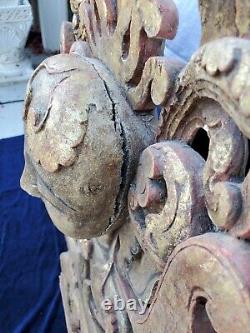
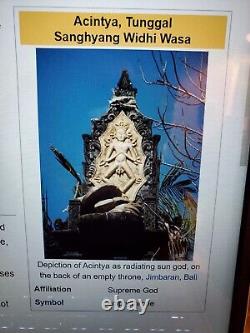


Antique Carved Wood Panel Sculpture of "Supreme God Acintya" Hindu Deity Museum Quality. 19th century and or early 20th century southeast Asian, Indonesian carved figure Hand Painted wood sculpture of Supreme God/ Deity is from Ubud Bali. Carved from wood and hand painted with touches of gold gilt by hand, this sculpture from Ubud Indonesia depicts the Hindu god, Acintya, standing and or laying on a bed of lotus flowers with flames. Acintya is regarded as the supreme God Hindu deity in Bali, and is associated with the sun, represented by the flames on his body. His nakedness refers to his consciousness dominating his senses.
This large antique wooden sculpture from Southeast Asia is intricately hand-carved as a relief panel wall hanging deity figure, is actually made from one piece of wood by a very skilled artist who most likely lived in Ubud, Indonesia. Ubud has been Bali's undisputed cultural and artistic capital and guardian of the authentic'Bali Spirit', the Balinese exceptional heritage of ancient arts and traditions. A spiritual mythological deity figure wall hanging panel of God almighty Acintya, the Balinese Hindu Supreme God of the sun, is still widely worshiped on the islands of Java, Bali, and Lombok, Indonesia. He is depicted in an elaborate headdress with a gilded crown and jewelry, ingulfed in flames with hints of red hand painted with accents of gold gilt details on crown, flames, and lotus flowers.
His hands are crossed while folded upwards towards the heart. This is a large yet delicate piece of artwork and needs to be handled with care, it is in good condition having small edge chips and roughness, with some visible cracks, paint loss, and wear consistent with the age and use. Overall Good condition please see photo's. Measurements are approximately 39.50H x 17.
"W x 3.50"D, weighing 10 lbs. 8 oz, with ready-to-hang hardware on the top portion. Is the Supreme God of.
, especially on the island of. Acintya is equivalent to the metaphysical concept of. Of Indian Hinduism, and is the Supreme God in traditional. All gods, goddesses and existence are believed to be the manifestation of the Acintya in Balinese Hinduism. Acintya corresponds to a rather recent trend towards monism.In Bali, according to which there is one supreme deity. And that all other gods are only manifestations. Acintya is emptiness, and considered as the origin of the Universe, all other divinities emanating from him. He is often associated to the sun god. And depicted in human form with flames around him.
His nakedness expresses that "his consciousness is no longer carried away by his sense-faculties". Prayers and offerings are not made directly to Acintya, but also to the other manifestations of the deity.
He is often not even represented, in which case he is only evoked by an empty throne. On top of a pillar the Padmasana. The introduction of the Padmasana as an altar to the Supreme God, was the result of a 16th-century Hindu reformation movement, led by Dang Hyang Nirartha.
The priest of the Gelgel. King Batu Renggong (also Waturenggong), at the time when Islam. Was spreading from the west through Java.Dang Hyang Nirartha built temples in Bali, and added the Padmasana shrines to the temples he visited. Since the end of World War II. And the Indonesian War of Independence. Has adopted the political philosophy of Pancasila. (literally, "The five principles"), which allows for freedom of religion.
The statute, however, requires that the religion in question be monotheistic. Based upon the belief in a single, omnipotent deity. Under this system, six religions are recognized: Islam. To comply with regulations, Balinese Hindus have felt the need to reinforce the monotheistic component of the faith, thus the more emphasized role of Acintya.To refer to him, they selected the term Sang Hyang Widhi Wasa (glossed as "God Almighty"), which although coined in the 1930s by Protestant missionaries to describe the Christian God. Was thought to be well-adapted to describe the Hindu supreme deity. This is thus the name which is now more commonly used by modern Balinese.

